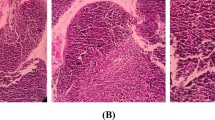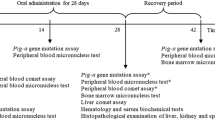Abstract
Perfluorooctanesulfonate (PFOS) is a widespread contaminant in the environment, as well as in wildlife and in humans. Toxicity tests in rodents have raised concerns about potential developmental, reproductive, and systemic effects of PFOS. However, there is little information about the effect of PFOS on immune system. In this study, adult male C57BL/6 mice were given by gavage 0, 5, 20 or 40 mg PFOS/kg day−1 for 7 days. The results showed that PFOS exposure decreased food intake and body weight and increased liver mass and serum corticosterone levels in a dose-dependent manner. Flow cytometry analysis showed that the number of lymphocytic subpopulation cells decreased significantly in 20 or 40 mg PFOS/kg day−1 group in comparison with normal C57BL/6 mice. Treatment with PFOS also markedly depressed the natural killer (NK) cell activity, lymphocyte proliferation and the plaque-forming cell (PFC) response. These results indicate that PFOS exposure can affect the immunity function in mice.







Similar content being viewed by others
References
3M Company (1999) Fluorochemical use, distribution, and release overview. 3M Company, St Paul
3M Company (2002) 104-Week dietary chronic toxicity and carcinogenicity study with perfluorooctane sulfonic acid potassium salt (PFOS; T-6295) in rats. Final Report, 3M T-6295 (Covance study no.: 6329-183), 2 January 2002, vols I–IX. 3M Company, St Paul, 4068 pp
Alexander BH, Olsen GW, Burris JM et al (2003) Mortality of employees of a perfluorooctanesulphonyl fluoride manufacturing facility. Occup Environ Med 60:722–729
Alici E, Konstantinidis KV, Sutlu T et al (2007) Anti-myeloma activity of endogenous and adoptively transferred activated natural killer cells in experimental multiple myeloma model. Exp Hematol 35:1839–1846
Ankley GT, Kuehl DW, Kahl MD et al (2005) Reproductive and developmental toxicity and bioconcentration of perfluorooctanesulfonate in a partial life-cycle test with the fathead minnow (Pimephales promelas). Environ Toxicol Chem 24:2316–2324
Austin ME, Kasturi BS, Barber M et al (2003) neuroendocrine effects of perfluorooctane sulfonate in rats. Environ Health Perspect 111:1485–1489
Bahjat KS, Prell RA, Allen HE et al (2007) Activation of immature hepatic NK cells as immunotherapy for liver metastatic disease. J Immunol 179:7376–7384
Boise LH, Thompson CB (1996) Hierarchical control of lymphocyte survival. Science 274:67–68
Burris JM, Lundberg JK, Olsen GW et al (2002) Determination of serum half-lives of several fluorochemicals. Interim Report #2. Available on USEPA Public docket AR-226 (No. 226-1086)
Butenhoff JL, Olsen GW, Pfahles-Hutchens A (2006) The applicability of biomonitoring data for perfluorooctanesulfonate to the environmental public health continuum. Environ Health Perspect 114:1776–1782
Calafat AM, Kuklenyik Z, Reidy JA et al (2007) Serum concentrations of 11 polyfluoroalkyl compounds in the US population: data from the national health and nutrition examination survey (NHANES). Environ Sci Technol 41:2237–2242
Chang SC, Thibodeaux JR, Eastvold ML et al (2008) Thyroid hormone status and pituitary function in adult rats given oral doses of perfluorooctanesulfonate (PFOS). Toxicology 243:330–339
Cunningham AJ, Szenberg A (1968) Further improvements in the plaque forming technique for detecting single antibody forming cells. Immmunology 14:599–601
Dean JH (1994) Immunotoxicology and immunopharmacology: Target organ toxicology series, 2nd edn edn. CRC Press, Boca Raton
de Vos MG, Huijbregts MA, van den Heuvel-Greve MJ et al (2007) Accumulation of perfluorooctane sulfonate (PFOS) in the food chain of the Western Scheldt estuary: comparing field measurements with kinetic modeling. Chemosphere. doi:10.1016/j.physletb.2003.10.071
DeWitt JC, Copeland CB, Strynar MJ et al (2008) Perfluorooctanoic acidinduced immunomodulation in adult C57BL/6J or C57BL/6N female mice. Environ Health Perspect. doi:10.1289/ehp.10896
Francis J, MohanKumar SMJ, MohanKumar PS (2000) Correlations of norepinephrine release in the paraventricular nucleus with plasma corticosterone and leptin after systemic lipopolysaccharide: blockade by soluble IL-1 receptor. Brain Res 867:180–187
Fuentes S, Colomina MT, Vicens P et al (2007) Concurrent exposure to perfluorooctane sulfonate and restraint stress during pregnancy in mice: effects on postnatal development and behavior of the offspring. Toxicol Sci 98:589–598
Giesy JP, Kannan K (2001) Global distribution of perfluorooctane sulfonate in wildlife. Environ Sci Technol 35:1339–1342
Hansen KJ, Clemen LA, Ellefson ME et al (2001) Compound-specific, quantitative characterization of organic fluorochemicals in biological matrices. Environ Sci Technol 35:766–770
Harada KH, Ishii TM, Takatsuka K et al (2006) Effects of perfluorooctane sulfonate on action potentials and currents in cultured rat cerebellar Purkinje cells. Biochem Biophys Res Commun 351:240–245
Higgins CP, McLeod PB, MacManus-Spencer LA et al (2007) Bioaccumulation of perfluorochemicals in sediments by the aquatic oligochaete Lumbriculus variegatus. Environ Sci Technol 41:4600–4606
Hong YH, Lillehoj HS, Lillehoj EP et al (2006) Changes in immune-related gene expression and intestinal lymphocyte subpopulations following Eimeria maxima infection of chickens. Vet Immunol Immunopathol 114:259–272
Houde M, Bujas TA, Small J et al (2006) Biomagnification of perfluoroalkyl compounds in the bottlenose dolphin (Tursiops truncatus) food web. Environ Sci Technol 40:4138–4144
Hyrcza MD, Kovacs C, Loutfy M et al (2007) Distinct transcriptional profiles in ex vivo CD4+ and CD8+T cells are established early in human immunodeficiency virus type 1 infection and are characterized by a chronic interferon response as well as extensive transcriptional changes in CD8+T cells. J Virol 81:3477–3486
Janeway CA, Travers P, Walport M, Capra JD (1999) Immunobiology: the immune system in health and disease, 4th edn. Garland Publishing, New York
Jerne NK, Nordin AA (1963) Plaque formation in agar by single antibody producingcells. Science 140:405
Jin Y, Saito N, Harada KH et al (2007) Historical trends in human serum levels of perfluorooctanoate and perfluorooctane sulfonate in Shenyang, China. Tohoku J Exp Med 212:63–70
Johnson JD, Gibson SJ, Ober RE (1984) Cholestyramine-enhanced fecal elimination of carbon-14 in rats after administration of ammonium [14C] perfluorooctanoate or potassium [14C] perfuorooctanesulfonate. Fundam Appl Toxicol 4:972–976
Kannan K, Franson JC, Bowerman WW et al (2001) Perfluorooctane sulfonate in fish-eating water birds including bald eagles and albatrosses. Environ Sci Technol 35:3065–3070
Kannan K, Hansen KJ, Wade TL et al (2002) Perfluorooctane sulfonate in oysters, Crassostrea virginica, from the Gulf of Mexico and the Chesapeake Bay, USA. Arch Environ Contam Toxicol 42:313–318
Keil DE, Mehlmann T, Butterworth L et al (2008) Gestational exposure to perfluorooctane sulfonate suppresses immune function in B6C3F1 mice. Toxicol Sci 103:77–85
Korzeniewski C, Callewaert DM (1983) An enzyme-release assay for nature cytotoxicity. J Immunol Methods 64:313–320
Lall SB, Dan G (1999) Role of corticosteroids in cadmium induced immunotoxicity. Drug Chem Toxicol 22:401–409
Liu C, Du Y, Zhou B (2007) Evaluation of estrogenic activities and mechanism of action of perfluorinated chemicals determined by vitellogenin induction in primary cultured tilapia hepatocytes. Aquat Toxicol 85:267–277
Luster MI, Rosenthal GJ (1993) Chemical agents and the immune response. Environ Health Perspect 100:219–226
Luster MI, Munson AE, Thomas PT et al (1988) Development of a testing battery to assess chemical-induced immunotoxicity: national toxicology program’s guidelines for immunotoxicity evaluation in mice. Fundam Appl Toxicol 10:2–19
Martin MT, Brennan RJ, Hu W et al (2007) Toxicogenomic study of triazole fungicides and perfluoroalkyl acids in rat livers predicts toxicity and categorizes chemicals based on mechanisms of toxicity. Toxicol Sci 97:595–613
Nakayama S, Strynar MJ, Helfant L et al (2007) Perfluorinated compounds in the Cape Fear Drainage Basin in North Carolina. Environ Sci Technol 41:5271–5276
Nelson DL, Frazier DE Jr, Ericson JE et al (1992) The effects of perfluorodecanoic acid (PFDA) on humoral, cellular, and innate immunity in Fischer 344 rats. Immunopharmacol Immunotoxicol 14:925–938
Organisation for Economic Co-operation and Development (OECD) (2002) Hazard assessment of perfluorooctane sulfonate (PFOS) and its salts. http://www.oecd.org/dataoecd/23/18/2382880.pdf
Olsen GW, Church TR, Miller JP et al (2003) Perfluorooctanesulfonate and other fluorochemicals in the serum of American Red Cross adult blood donors. Environ Health Perspect 111:1892–1901
Peden-Adams MM, EuDaly JG, Dabra S et al (2007) Suppression of humoral immunity following exposure to the perfluorinated insecticide sulfluramid. J Toxicol Environ Health A 70:1130–1141
Reichlin S (2004) Neuroendocrinology of acute immunity. J Endocrinol Invest 27:48–61
Saito N, Harada K, Inoue K et al (2004) Perfluorooctanoate and perfluorooctane sulfonate concentrations in surface water in Japan. J Occup Health 46:49–59
Senthilkumar K, Ohi E, Sajwan K et al (2007) Perfluorinated compounds in river water, river sediment, market fish, and wildlife samples from Japan. Bull Environ Contam Toxicol 79:427–431
Seacat AM, Thomford PJ, Hansen KJ et al (2003) Sub-chronic dietary toxicity of postassium perfluorooctanesulfonate in rats. Toxicology 183:117–131
Shakhar G, Blumenfeld B (2003) Glucocorticoid involvement in suppression of NK activity following surgery in rats. J Neuroimmunol 138:83–91
Starkov AA, Wallace KB (2002) Structural determinants of fluorochemical- induced mitochondrial dysfunction. Toxicol Sci 66:244–252
Tittlemier SA, Pepper K, Seymour C et al (2007) Dietary exposure of Canadians to perfluorinated carboxylates and perfluorooctane sulfonate via consumption of meat, fish, fast foods, and food items prepared in their packaging. J Agric Food Chem 55:3203–3210
Trinchieri G (1989) Biology of natural killer cells. Adv Immunol 47:187–376
Vial T, Nicolas B, Descotes J (1996) Clinical immunotoxicity of pesticides. J Toxicol Environ Health A 48:215–229
Wu R, Coleman N, Stanley M (1996) Different susceptibility of cervical keratinocytes containing human papillomavirus to cellmediated cytotoxicity. Chin Med J 109:854–858
Yang Q, Xie Y, Depierre JW (2000) Effects of peroxisome proliferators on the thymus and spleen of mice. Clin Exp Immunol 122:219–266
Yang Q, Xie Y, Eriksson AM et al (2001) Further evidence for the involvement of inhibition of cell proliferation and development in thymic and splenic atrophy induced by the peroxisome proliferator perfluoroctanoic acid in mice. Biochem Pharmacol 62:1133–1140
Yang Q, Abedi-Valugerdi M, Xie Y et al (2002) Potent suppression of the adaptive immune response in mice upon dietary exposure to the potent peroxisome proliferator, perfluorooctanoic acid. Int Immunopharmacol 2:389–397
Young CJ, Furdui VI, Franklin J et al (2007) Perfluorinated acids in Arctic snow: new evidence for atmospheric formation. Environ Sci Technol 41:3455–3461
Acknowledgments
This research was supported by Grants from the National Natural Science Foundation of China (20707041) and Grants from the Research Found for the Doctor Program of Higher Education (20070159015).
Author information
Authors and Affiliations
Corresponding author
Rights and permissions
About this article
Cite this article
Zheng, L., Dong, GH., Jin, YH. et al. Immunotoxic changes associated with a 7-day oral exposure to perfluorooctanesulfonate (PFOS) in adult male C57BL/6 mice. Arch Toxicol 83, 679–689 (2009). https://doi.org/10.1007/s00204-008-0361-3
Received:
Accepted:
Published:
Issue Date:
DOI: https://doi.org/10.1007/s00204-008-0361-3




